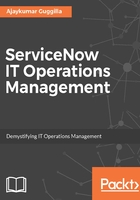
MID Server use case in an orchestration workflow
In the following figure, we can see how an MID Server is utilized in an orchestration workflow:

In the preceding figure, MID Server is used to perform an orchestration workflow. The following steps show how the communication happens from the ECC queue to the MID Server and back to the orchestration workflow:
- When an orchestration workflow is run, a probe record is created
- MID Server checks the output queue every 15 seconds and receives the probe record from the output queue.
- MID Server finds the probe record and it reads through and executes against the specified target system or infrastructure component.
- MID Server now returns the response back of the payload from the probe into the input queue.
- Orchestration workflow looks at the output queue on the response back from the MID Server and follows the rest of the defined orchestration steps or scripts that need to be executed.
MID Server, which is placed in the corporate networks, queries every 15 seconds to search for probe records. These parameters of 15 seconds frequencies can be adjusted to avoid unnecessary traffic in a multiple MID Server deployment scenario.
Once the probe records are executed, the results are posted back to the ServiceNow instance. Sensors are processors of the probe records, sensors decide how to precede on communicating with the particular infrastructure component. MID Server makes only outbound calls with no inbound calls made from ServiceNow to the MID Server. MID Server communications are securely initiated through SOAP on the HTTPS (port 443) within the enterprise firewall.
Unlike how different people talk different languages to communicate, MID Server uses different probe technologies to communicate with different types of infrastructure components, some of them include PowerShell, SSH, and so on.